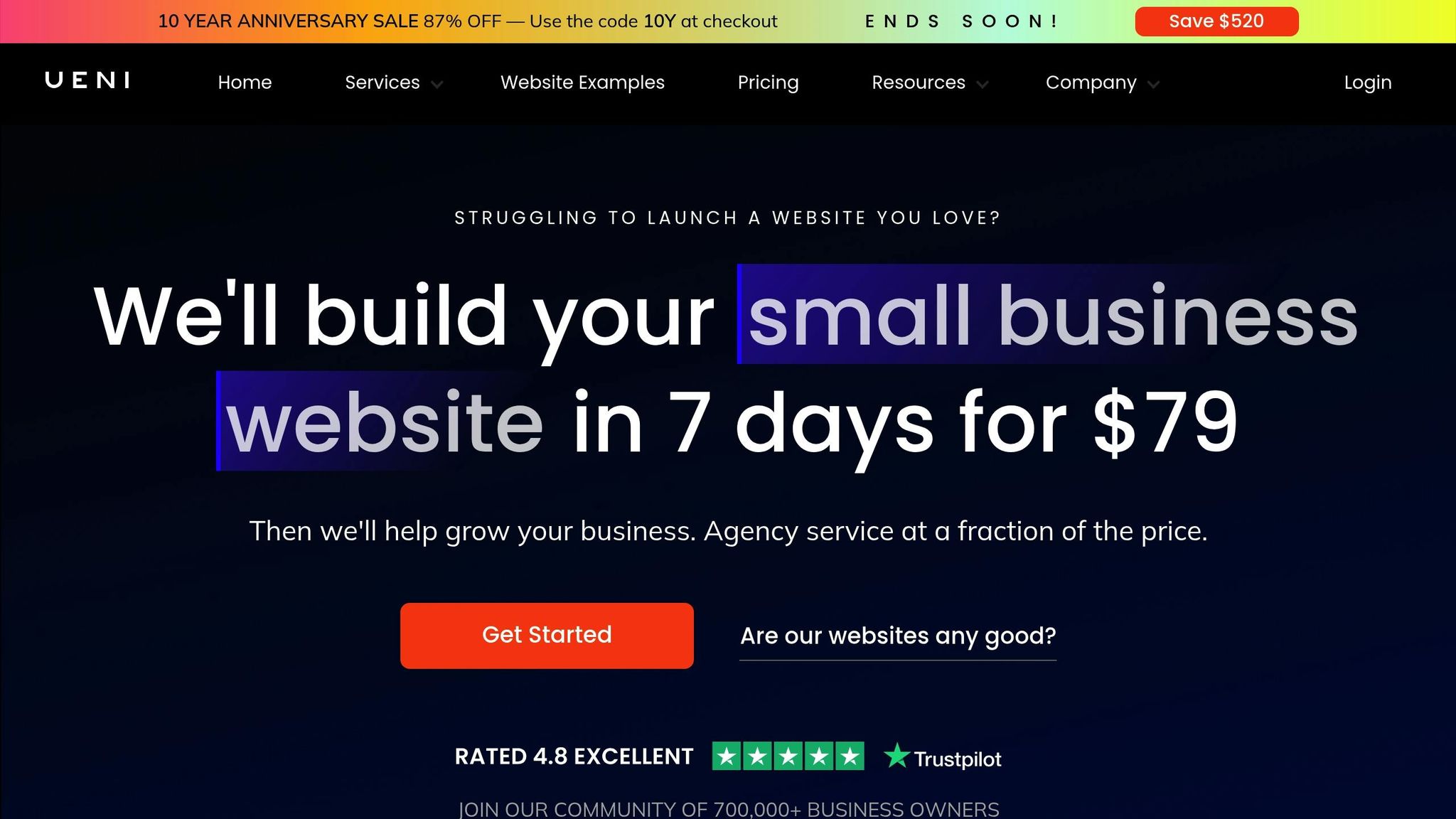Your domain name is your online address and a key part of your business identity. It helps customers find you, builds trust, and allows for professional email addresses. Here’s everything you need to know about choosing, registering, and managing a domain:
- What is a Domain Name?: A unique web address (e.g., yourbusiness.com) made of a name and an extension (.com, .net, etc.).
- Why It Matters: It boosts professionalism, improves search visibility, and ensures control over your online presence.
- How to Choose: Keep it short, easy to spell, and include your business name or relevant keywords.
- Registration Details: Costs vary (usually $10–$15/year for .com), and domains are leased yearly. Use privacy services to protect your contact info.
- Management Tips: Enable auto-renewals, use secure passwords, and monitor DNS settings.
Pro Tip: A .com extension is the most trusted and widely recognized, especially in the U.S.
This guide also covers integrating domains with email, hosting, and business tools, ensuring your domain works seamlessly with your operations. Read on to learn how to secure and manage a domain that supports your business growth effectively.
How to Choose the Right Domain Name
Picking the perfect domain name is a mix of creativity and practicality. Your domain is essentially your online identity – something that will stick with your business for years. It’s worth investing the time to get it right. A great domain name is easy to remember, professional, and aligned with your brand.
Best Practices for Domain Name Selection
Keep it short and simple. Ideally, aim for a domain name that’s between 6-14 characters. Shorter names are easier to type, remember, and share. They also look cleaner, whether in print or online.
Make it easy to spell and pronounce. Avoid tricky spellings, hyphens, or numbers. If someone hears your domain name spoken, they should be able to spell it without confusion. For instance, "quick" is easier than "kwik", and "center" is more straightforward than "centre" for U.S. audiences.
Incorporate your business name. Whenever possible, include your business name in the domain. For example, if your business is "Miller’s Bakery", try to secure a domain like millerbakery.com or millersbakery.com. This reinforces your brand and makes it easier for customers to find you.
Use relevant keywords wisely. Keywords can be helpful, but readability should come first. A domain like "ryanplumbing.com" strikes a good balance – it’s professional and memorable without being overly stuffed with keywords.
Test it aloud. Say your domain name out loud and see if others can spell it correctly. This quick test helps ensure your domain works well in conversation, not just on paper.
Avoid trademark conflicts. Before you commit to a domain, do a quick check to ensure it doesn’t infringe on any trademarks. The U.S. Patent and Trademark Office database is a great place to start.
Once you’ve narrowed down your options, take some time to review the legal and practical aspects of securing your domain.
Legal and Practical Considerations
After identifying a strong domain name, make sure it’s legally and practically sound.
Check availability across extensions. Even if you plan to use a .com domain, see if .net or .org versions are available. While a domain might be technically available, it could still pose legal risks if another business has trademark rights to that name, especially in your industry or region.
Understand your registration rights. Registering a domain gives you exclusive use for a set term, typically one year. As long as you renew it, the domain remains yours.
Think about future growth. If your current domain is location-specific, like "JohnsBostonPizza.com", but you plan to expand to other cities, consider a more flexible option like "JohnsPizzaCo.com." This ensures your domain grows with your business.
Keep track of registration details. Document when you registered the domain, its expiration date, and the contact information tied to it. This information is crucial for renewals and any changes you might need to make.
Be cautious of domain squatting. Some individuals register domains they think businesses might want, hoping to sell them at inflated prices. If your ideal domain is listed as "for sale", you can try negotiating or consider an alternative.
Domain Privacy and Security
Beyond securing the right name, protecting your domain and personal information is essential for long-term success.
Use domain privacy services. When you register a domain, your contact details become public. Privacy services can mask this information, reducing spam and protecting your identity.
Enable two-factor authentication. Most registrars offer two-factor authentication, which adds an extra layer of security to your account. This step can prevent unauthorized access to your domain settings.
Set up automatic renewals. To avoid accidentally losing your domain, enable automatic renewal. Just make sure your payment details are up to date – an expired credit card could cause your domain to lapse.
Monitor your domain’s security. Regularly check your domain’s DNS settings for unauthorized changes. Many registrars offer monitoring services to alert you of suspicious activity.
Consider an SSL certificate. While not part of domain registration, an SSL certificate encrypts data between your site and visitors. It’s crucial for customer trust and can even boost your search rankings. Many hosting providers include basic SSL certificates.
Plan for potential transfers. If you ever need to switch registrars or transfer ownership, familiarize yourself with the process. Keep your contact information current and know where to find your domain’s authorization code.
A well-chosen domain name does more than represent your business – it becomes a critical part of your online identity. By addressing these factors upfront, you can prevent costly mistakes and ensure your domain serves your business for years to come.
Understanding Domain Registration and Management
Once you’ve chosen the perfect domain name, the next step is learning how to register and manage it properly. While the process might seem simple, there are details that can affect your business long-term. Knowing what to expect can help you avoid common mistakes and make smarter choices.
How Domain Registration Works
Domain registration is overseen globally by ICANN, a nonprofit organization that manages the internet’s naming system. ICANN accredits companies, known as registrars, to sell domain names to the public.
When you register a domain, you’re essentially leasing it for a set period, typically a year at a time. The registrar acts as a middleman between you and the global domain database. Each registrar offers different pricing and features, so it’s worth comparing options.
The process begins with searching for your desired domain name to check availability. If it’s available, you’ll need to provide your contact information, including your name, address, phone number, and email.
Domain costs can vary widely depending on the extension and registrar. For example, standard .com domains usually cost $10–$15 per year, while premium or specialized domains can run into hundreds or even thousands annually. Some registrars offer discounted rates for the first year, but renewal prices are often higher.
After you pay, your domain goes through a verification period. ICANN requires registrars to verify the email address linked to your domain within 15 days. Failing to respond to the verification email can result in your domain being suspended until the process is complete.
During registration, DNS (Domain Name System) settings are automatically configured. Your registrar assigns default name servers, which direct your domain to a placeholder page until you connect it to a website or email service. You can update these settings later to point your domain where you need it.
Domain Ownership and Transfers
Once your domain is registered, managing it effectively is crucial. Your domain represents your online identity, and maintaining clear ownership is key. When you register a domain, you become the registrant, meaning you legally own the domain for the duration of the registration period.
The WHOIS database lists the registrant’s contact information, making this person or organization the legal owner. This role includes the authority to make changes, transfer ownership, or decide not to renew. For businesses, it’s wise to register domains under the company name and keep WHOIS details updated to avoid issues during ownership changes or transfers.
If you want to switch registrars, domain transfers allow you to move your domain elsewhere. Reasons for transferring might include better pricing, improved support, or additional features. Transfers generally take 5–7 days and require an authorization code (also known as an EPP code) from your current registrar.
However, transfer restrictions apply in certain situations. For example, domains can’t be transferred within 60 days of initial registration or a previous transfer. Additionally, domains locked due to disputes or unpaid fees cannot be transferred until the issue is resolved.
For growing businesses, domain management becomes even more important. Many companies register domains under the business name rather than an individual’s name to avoid complications if employees leave. Assigning multiple administrative contacts can also ensure smooth management, even during personnel changes.
To maintain ownership, it’s essential to renew your domain on time.
Renewal and Expiration Policies
Renewing your domain is one of the most critical aspects of managing it. Missing a renewal deadline can result in losing your domain, which could seriously impact your online presence.
Renewal timing depends on the registrar, but most allow renewals up to a year before expiration. Registrars typically send renewal reminders starting about 90 days before the deadline, with frequent follow-ups as the date approaches. However, relying solely on these reminders isn’t recommended – keeping your own renewal calendar is a smart move.
If you miss the deadline, many domains enter a grace period lasting 0–45 days. During this time, you can still renew at the standard rate, though your website and email may stop working. After the grace period, domains often enter a 30-day redemption period, where renewal is still possible but comes with extra fees, usually $100–$200 on top of the regular cost.
To avoid accidental expiration, consider using auto-renewal services. Most registrars offer this feature, which automatically charges your payment method before your domain expires. Just make sure your payment information is up to date – a canceled credit card could still lead to a lost domain.
For those managing multiple domains, bulk renewals can save time and sometimes money. Registrars often offer discounts for renewing multiple domains or extending registration periods.
Finally, monitoring and alerts are essential for staying on top of renewal dates. Use calendar reminders or domain management tools to track expiration dates across all your domains.
Successful domain management isn’t a one-time task – it’s an ongoing process. By monitoring your domains regularly, renewing them on time, and keeping accurate records, you can ensure they remain a solid foundation for your online presence.
Integrating Domains with Business Tools
Once you’ve secured and managed your domain, the next step is connecting it to essential business tools. Think of your domain as the central hub that links your professional communications, website, and other business applications. Proper integration ensures your online presence is cohesive and functional. Here’s how to make it happen.
Professional Email Addresses
One of the quickest ways to use your domain is by creating professional email addresses. Instead of relying on generic email providers, addresses like contact@yourbusiness.com or info@yourbusiness.com immediately convey credibility and professionalism.
Setting up domain-based email involves configuring MX records in your DNS settings. These records direct email servers to deliver messages to the right destination. Note that changes to MX records may take up to 48 hours to propagate fully.
Using professional email addresses offers more than just a polished image. They allow for better organization, such as creating dedicated addresses like sales@yourbusiness.com, support@yourbusiness.com, or billing@yourbusiness.com, each tailored to specific business needs.
Costs for email hosting typically range from $3 to $10 per mailbox per month, depending on the provider and included features like storage, calendar integration, and mobile syncing. Some domain registrars even offer bundled email hosting, streamlining management by keeping everything in one place.
Security is a top priority for business email. Look for providers that include features like two-factor authentication, encrypted connections, and spam filtering. These measures not only protect sensitive information but also build trust with your customers.
Website Hosting and Online Presence
Your domain isn’t just an address – it becomes a fully functional website when paired with reliable hosting. To connect your domain to hosting, you’ll need to update A records or CNAME records in your DNS settings to point to your hosting provider’s servers.
Think of it this way: your domain is your address, and hosting is the building at that address. You can switch hosting providers without changing your domain, offering flexibility as your business grows.
For small business websites with moderate traffic, shared hosting plans are a cost-effective option, typically priced at $3-$15 per month. These plans often include features like one-click installations for platforms like WordPress, SSL certificates, and basic security. If your business expects higher traffic or needs more control, VPS hosting starts around $20-$50 per month.
An SSL certificate is crucial for both security and search engine rankings. While most hosting providers offer free SSL certificates, you’ll need to configure them correctly to ensure they work seamlessly with your domain.
To improve website performance, consider using a Content Delivery Network (CDN). CDNs speed up loading times by distributing content through servers closer to your visitors. Many hosting providers include CDN services, or you can add them separately for $5-$20 per month.
If you’re using a website builder or content management system, domain integration is often straightforward. These platforms typically handle the technical DNS setup for you, making it easier to focus on your business.
Other Integrations: Bookings, SEO, and More
Your domain can also connect to tools that enhance customer interactions and business operations:
- Online Booking Systems: Use subdomains like bookings.yourbusiness.com or integrate scheduling tools directly into your main website for a seamless customer experience.
- SEO Tools: Platforms like Google Search Console require domain verification to provide analytics and optimization tips. This usually involves adding DNS records or uploading verification files to your site.
- CRM Systems: Tools like HubSpot and Salesforce integrate with your domain to track visitor interactions and evaluate marketing efforts. These systems help identify which campaigns generate the most valuable leads.
- Social Media Tracking: Tools like Facebook Pixel need domain verification to measure the success of social media ads. This integration ensures accurate tracking of leads and conversions.
- Reputation Monitoring: Services like Google Alerts can track mentions of your domain online, keeping you informed about customer reviews, news coverage, or potential issues.
- E-commerce Tools: Payment processors, inventory systems, and shipping calculators work more effectively when integrated with your domain. These often require specific DNS configurations or tracking code installations.
- Analytics Platforms: Tools like Google Analytics provide insights into customer behavior. Adding tracking codes to your website or configuring DNS settings allows for detailed analysis, including cross-domain tracking.
To ensure smooth integration, plan ahead. Research the domain requirements for each tool and confirm that your DNS provider supports the necessary configurations. A user-friendly DNS interface can save you time and reduce frustration as your business grows.
sbb-itb-5b82b38
UENI’s Domain Solutions for Small Businesses

Managing domains, hosting, and email can be a headache for small business owners. UENI takes that burden off your plate with an all-in-one service that handles every technical detail for you. By simplifying domain, hosting, and email management, UENI not only saves you time but also strengthens your online presence and brand identity.
Custom Domains and Professional Email
With every UENI plan, you get a custom domain name and matching professional email addresses – no need to purchase these separately or wrestle with complicated integrations. Whether you’re registering a new domain or connecting an existing one, UENI guides you every step of the way, and it’s all included in your plan.
A quick questionnaire helps identify the best domain options for your business, and UENI takes care of all the technical setup. Professional email addresses like contact@yourbusiness.com are automatically configured, along with the necessary MX records and DNS settings. That means no dealing with technical jargon or waiting for propagation delays.
"Along with your domain name, UENI provides a professional business email inbox that corresponds with your domain. This feature is supported by your monthly subscription and helps to maintain brand continuity and credibility for your business."
– TRUiC Team, Startupsavant.com
Plans include one to four email inboxes, depending on your needs, which makes scaling your business communications easy. This seamless setup ensures a smooth onboarding experience and eliminates the need for separate email hosting services.
Guided Setup and Onboarding
UENI doesn’t just hand you the tools – it does the heavy lifting for you. From DNS settings to hosting and email configurations, UENI’s specialists take care of everything. Once you’ve completed the initial questionnaire, their team builds your website, sets up your domain, configures your email, and ensures everything works flawlessly.
After the setup is complete, UENI hosts a one-on-one call to walk you through your new website and email system. They’ll also provide tips on managing your domain features. The entire process, including domain registration or transfer, hosting setup on Amazon Web Services, SSL certificate installation, and email configuration, typically takes about seven days. If you already have a domain, UENI will assist with DNS adjustments or registrar changes to make the transition seamless.
More Than Just Domains
UENI’s domain services go beyond the basics. Their plans include secure hosting, SSL certificates, and ongoing maintenance, all tailored to the needs of small businesses.
Hosting is powered by Amazon Web Services, offering reliable, secure performance with unlimited resources for typical small business operations. UENI handles all server updates and maintenance, so you don’t have to.
SSL certificates are automatically installed and renewed, keeping your website secure and preventing those dreaded browser security warnings – especially important for businesses handling online payments or sensitive customer data.
"Packages include unlimited hosting, tech maintenance, a custom domain, and a business email inbox."
– TRUiC Team, Startupsavant.com
Pricing starts at $16.99 per month, with a one-time $79 setup fee. This covers everything: domain registration and renewal, professional email, hosting, and ongoing technical support. Plus, UENI’s integrated Business Hub makes it easy to manage your domain services, website updates, email, and even local SEO features like Google Business Profile optimization – all from one platform.
For businesses that need frequent updates, higher-tier plans offer unlimited professional edits. This includes domain-related changes, such as adding new email addresses, updating DNS records for integrations, or creating subdomains for specific purposes.
Conclusion: Building Your Online Presence with the Right Domain
Your domain name isn’t just a web address – it’s the cornerstone of your business’s digital identity. With over 600,000 small businesses starting each year in the United States, standing out online is more important than ever. The right domain can be the bridge that connects you to potential customers, making your business memorable and accessible.
Consider this: 77% of U.S. internet users believe a website makes a business seem more credible, and 84% trust businesses with websites more than those relying solely on social media. When 91% of consumers turn to the internet to find local goods or services, your domain becomes your digital storefront – a first impression that can either invite customers in or turn them away. These numbers highlight just how critical a strong domain is for your success.
Picking the right domain means focusing on clarity, relevance, and professionalism. A well-thought-out domain not only boosts your brand identity but also protects your online presence and gives you full control over your digital footprint. Plus, it allows for professional email addresses, which can significantly enhance trust – 74% of U.S. internet users say they trust company-branded email addresses over generic ones.
For small business owners juggling countless responsibilities, UENI simplifies the process by offering custom domains and professional email as part of its all-in-one solution [1]. With UENI, you can enjoy an easy setup, expert guidance, and ongoing support through its Business Hub, which centralizes your website, email, and online presence management [1][5]. This hands-off approach lets you focus on growing your business while ensuring your domain works hard for you.
In a world where 92% of consumers prefer getting information from a business website over social media, having the right domain ensures your business is easy to find, remember, and trust. With a strong domain and the right tools, you’re not just creating a website – you’re building a professional online presence that evolves with your business.
FAQs
How can I make sure my domain name is legally protected and doesn’t violate trademarks?
Before registering your domain name, it’s smart to check the U.S. Patent and Trademark Office (USPTO) database. Search for exact matches, synonyms, and similar spellings of the name you have in mind. This step can help you spot potential conflicts and steer clear of trademark problems down the road.
If your domain name is similar to an existing trademark, think about whether your website might overlap with their products or services, share distribution channels, or cause confusion among customers. These factors could lead to legal trouble or even lost business. When in doubt, reaching out to a legal expert can help you navigate these tricky waters.
Another option to protect your brand is registering your own trademark. This can give you stronger legal footing, making it harder for others to use a name that’s too close to yours for competing purposes. It’s an effective way to safeguard your brand’s identity and reputation.
What happens if I don’t renew my domain on time, and how can I avoid losing it?
Failing to renew your domain on time can cause a range of problems. Your website could go offline, cutting off access for visitors and potentially affecting your SEO rankings. Even worse, you might lose access to any email accounts tied to the domain, disrupting communication with customers. If the domain remains unrenewed for too long, it could even be purchased by someone else – possibly even a competitor.
To prevent this, set up auto-renewal with your domain registrar and double-check that your payment details are current. Most registrars also send renewal reminders, typically about a month and a week before expiration. Keep an eye on those alerts so you can act before it’s too late.
How can I use my domain to set up email and website hosting for a stronger online presence?
Using your domain for email and website hosting is a smart way to boost your business’s online image. Custom email addresses that match your domain name – like info@yourbusiness.com – can make your business appear more trustworthy and professional compared to using generic email providers.
Many hosting providers offer plans that bundle website and email hosting, simplifying management by keeping everything in one place. Once your domain is set up, you can also connect email services to your website, making it easier to communicate with your audience. Together, these tools help you build a polished and unified online presence for your business.









